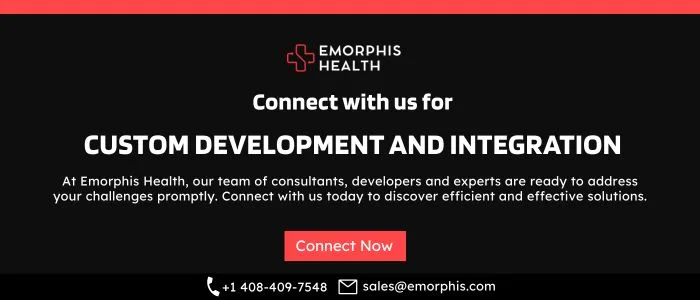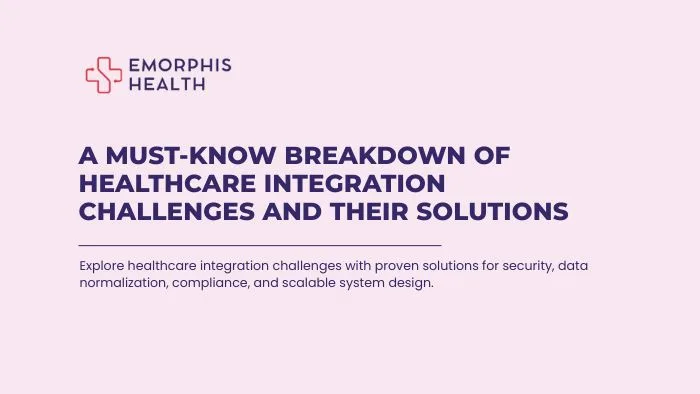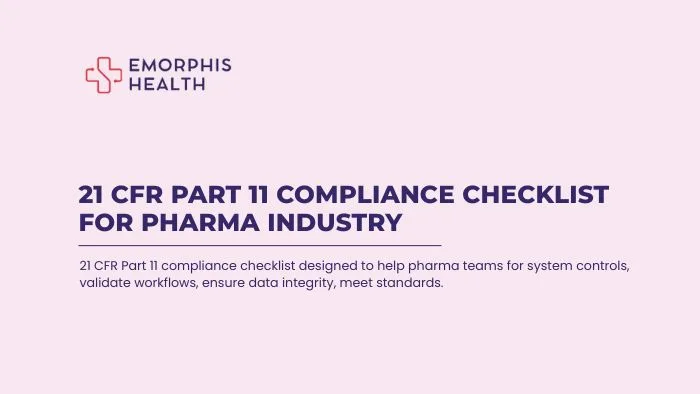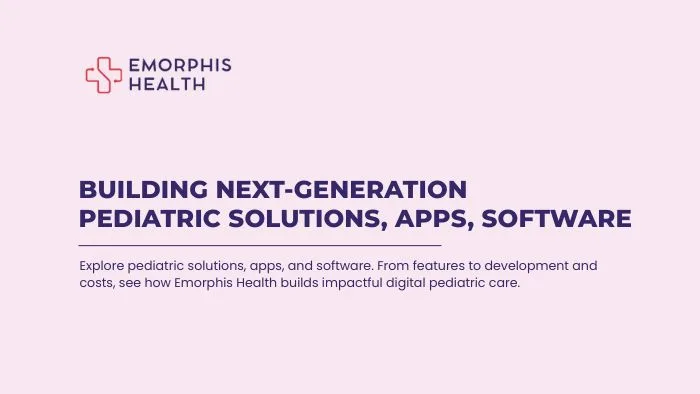Introduction
See Contents
Healthcare is undergoing a major transformation as digital technologies redefine how care is delivered. Hospitals, clinics, and care providers are increasingly investing in Healthcare IT solutions to improve patient outcomes, streamline operations, and maintain compliance with regulatory standards. From remote monitoring to AI-driven analytics, these solutions are empowering healthcare organizations to provide proactive, personalized, and efficient care.
Let us now explore how Healthcare IT solutions are being applied across various diseases, the technologies powering them, and their impact on patient care.
The Growing Need for Healthcare IT Solutions
Modern healthcare faces multiple challenges: chronic disease prevalence, aging populations, and increasing regulatory requirements. Hospitals must manage massive amounts of patient data, coordinate complex care teams, and ensure secure sharing of sensitive information.
This is where Healthcare IT solutions become essential. They enable:
- Operational efficiency: Automating administrative tasks, scheduling, and billing.
- Data integration: Connecting labs, pharmacies, and imaging departments for seamless information flow.
- Patient engagement: Providing portals and apps for patients to track their health and communicate with providers.
- Telemedicine support: Allowing remote consultations and monitoring, which is critical for patients with mobility or accessibility challenges.
By implementing robust Healthcare IT solutions, hospitals can reduce errors, improve workflow efficiency, and focus on delivering high-quality care.


Key Technologies Powering Healthcare IT Solutions
1. Electronic Health Records (EHR) & Electronic Medical Records (EMR)
EHRs and EMRs form the backbone of any healthcare IT system. These platforms centralize patient information, including medical history, lab results, medications, and imaging reports. Advanced EHRs integrated with AI provide insights into patient risks, allowing providers to make informed decisions quickly.
2. Artificial Intelligence & Machine Learning
AI and machine learning models are increasingly used for predictive analytics, risk stratification, and early detection of disease. For example, AI can analyze imaging data for early signs of cancer or predict potential cardiac events in high-risk patients.
3. Telehealth Platforms & Virtual Care
Telehealth platforms enable remote consultations, follow-ups, and the management of chronic diseases. Integrated with patient monitoring systems, these platforms allow providers to respond promptly to health alerts and reduce unnecessary hospital visits.
4. Internet of Things (IoT) & Wearables
IoT devices like smart inhalers, connected glucose monitors, and wearable ECG sensors continuously track vital signs. These devices feed real-time data into the hospital’s IT system, enabling proactive interventions and personalized care plans.
5. Cloud Computing & Secure Data Storage
Cloud platforms provide scalable, secure storage for patient data while enabling interoperability between healthcare providers. Cloud-based Healthcare IT solutions support big data analytics, telemedicine, and real-time decision-making.
6. Blockchain & Healthcare Security
Blockchain ensures data integrity and security, especially for sensitive patient records. It enables transparent data sharing between authorized providers while complying with HIPAA and GDPR standards.
Healthcare IT Solutions for Specific Diseases
a. Cardiovascular Diseases
Cardiovascular diseases such as heart failure, arrhythmia, and stroke remain among the leading causes of death worldwide. Continuous patient data monitoring and predictive intervention are critical, and Healthcare IT solutions provide the foundation for this proactive care model.
- AI-assisted ECG and echocardiogram analysis: Cloud-based algorithms analyze ECG signals in milliseconds, identifying arrhythmias or ischemic patterns far earlier than traditional interpretation. These systems can be integrated with EHRs to trigger automatic alerts for clinicians.
- Remote cardiac monitoring platforms: Wearable patches, Bluetooth-enabled BP monitors, and cardiac telemetry devices transmit real-time data to cloud dashboards accessible to care teams, enabling post-discharge monitoring and reduced readmissions.
- Predictive analytics for cardiovascular risk: Machine learning models evaluate patient lifestyle data, lab results, and vitals to forecast heart failure events or stroke risk, allowing early intervention through medication or behavioral changes.
- Telecardiology systems: Secure teleconsultation tools allow cardiologists to view live ECG feeds and echocardiograms remotely, enhancing access to specialist care in rural areas.
- Digital twin models: Emerging systems simulate a patient’s heart using imaging and physiological data to test drug response and surgical plans before actual treatment.
Together, these technologies form an ecosystem that transforms reactive cardiac care into a continuously learning, AI-guided preventive network.
b. Diabetes Management
Diabetes care is becoming increasingly data-driven. From insulin delivery automation to AI-powered predictive modeling, IT-enabled systems are helping patients and clinicians maintain tighter glucose control and anticipate complications before they occur.
- Integrated glucose monitoring systems: Continuous glucose monitors (CGMs) stream real-time data to mobile health apps. These apps use algorithms to detect patterns and send proactive alerts about hypo- or hyperglycemia.
- Smart insulin delivery devices: Closed-loop insulin pumps use AI algorithms to adjust insulin delivery based on CGM readings, diet, and activity levels, effectively creating an “artificial pancreas.”
- Cloud-based data analytics dashboards: Clinicians can remotely monitor glucose trends of multiple patients, identify outliers, and modify medication plans instantly.
- Digital twin and predictive analytics: Predictive models forecast risks like neuropathy, retinopathy, and nephropathy, helping healthcare teams intervene early with precision therapies.
- Patient engagement and education apps: Gamified platforms encourage healthy habits, remind patients of insulin schedules, and provide real-time feedback on diet and exercise compliance.
These interoperable systems enable a closed feedback loop between patients, caregivers, and clinicians—reducing emergency admissions and improving quality of life.
c. Cancer (Oncology)
Oncology generates massive amounts of data—from genomic sequencing to imaging scans and clinical trial results. Healthcare IT solutions integrate these silos, empowering oncologists to personalize therapy based on the unique biological profile of each tumor.
- AI-driven imaging analytics: Deep learning algorithms analyze MRI, PET, and CT scans to identify tumor boundaries, size progression, and therapy response. These tools assist in early-stage cancer detection and treatment planning.
- Genomic and molecular data integration: Bioinformatics platforms connect patient genomic sequences with drug databases, enabling precision medicine recommendations based on specific mutations.
- Clinical decision support systems (CDSS): Oncology-specific CDSS tools suggest treatment protocols based on evidence-based guidelines, reducing variability in care.
- Clinical trial matching platforms: AI tools analyze EHR data to identify patients eligible for ongoing clinical trials, accelerating access to innovative therapies.
- Multidisciplinary collaboration portals: Oncologists, radiologists, and pathologists can co-review digital pathology slides and imaging scans through secure cloud interfaces.
These advanced IT systems ensure that every decision in cancer care is data-backed, timely, and precisely tailored to the individual.


d. Chronic Respiratory Diseases
Asthma and Chronic Obstructive Pulmonary Disease (COPD) require close tracking of breathing patterns, environmental triggers, and medication adherence. Healthcare IT transforms this into a continuous, connected care model.
- IoT-enabled smart inhalers: These devices automatically record medication use and inhalation technique, transmitting data to healthcare apps to monitor adherence.
- Remote pulmonary monitoring platforms: Connected spirometers, pulse oximeters, and wearable sensors collect data on lung function, oxygen saturation, and respiratory rate.
- AI-based symptom prediction models: Predictive systems detect early warning signs of respiratory flare-ups based on trends in cough frequency, heart rate, and environmental air quality.
- Telepulmonology and video consultations: Patients can receive follow-ups from pulmonologists remotely, reducing the need for frequent hospital visits.
- Environmental data integration: IoT and cloud analytics correlate patient symptoms with external air pollution, pollen, or humidity levels, helping clinicians identify environmental triggers.
These connected solutions not only prevent acute exacerbations but also provide physicians with data-driven insights for long-term disease management.
e. Neurological Disorders
Conditions like Parkinson’s, Alzheimer’s, and epilepsy require continuous observation and multi-dimensional data interpretation. AI and wearable technologies are changing how neurological disorders are managed and treated.
- Wearable sensors for movement and tremor tracking: Accelerometers and gyroscopes detect subtle motor changes, providing quantitative data on disease progression.
- AI-powered cognitive assessment apps: Machine learning models analyze speech, reaction times, and memory test data to detect early signs of cognitive decline.
- Virtual rehabilitation and brain training platforms: Patients engage in guided exercises through AR/VR environments to enhance cognitive and motor recovery.
- Tele-neurology consultation systems: Specialists can remotely analyze EEGs, MRIs, or patient movement videos for accurate diagnosis.
- Data fusion and predictive analytics: Combined datasets from wearables, imaging, and genetic profiles help build predictive models for disease trajectory.
These systems turn neurological monitoring into a precise, data-informed process—empowering physicians and caregivers with continuous, personalized insights.
f. Mental Health Disorders
Mental health disorders require accessibility, confidentiality, and continuous engagement. Healthcare IT makes mental healthcare scalable and stigma-free by blending AI, telemedicine, and behavioral analytics.
- Teletherapy platforms: HIPAA-compliant virtual care platforms connect patients with certified therapists, allowing real-time sessions and secure follow-ups.
- AI-powered conversational agents: Chatbots such as Woebot or Wysa provide emotional support, daily mood tracking, and CBT (Cognitive Behavioral Therapy)-based interventions.
- Digital therapeutics apps (DTx): Prescription-based apps deliver clinically validated interventions for depression, anxiety, and substance use disorders.
- Behavioral analytics dashboards: AI analyzes voice tone, text sentiment, and engagement frequency to detect mood deterioration or potential crises.
- Integration with EHR and population health systems: Enables tracking of mental health outcomes as part of holistic patient management.
Through digital tools, mental health support becomes accessible 24/7 while ensuring privacy and data integrity.
g. Kidney & Rare Diseases
Managing chronic kidney disease (CKD) and rare disorders requires extensive coordination across labs, imaging centers, and specialists. Healthcare IT brings cohesion and foresight to these complex care networks.
- AI-driven renal function monitoring: Algorithms analyze serum creatinine, eGFR, and urine data to detect deterioration before symptoms appear.
- Dialysis management platforms: Automate scheduling, machine calibration logs, patient symptom reporting, and supply chain management for dialysis centers.
- Genomic analytics for rare diseases: Identify genetic mutations and match patients to targeted therapies using integrated genomic databases.
- Remote monitoring dashboards: Track patients’ fluid balance, diet compliance, and medication adherence through IoT-enabled wearables.
- Care coordination systems: Unify nephrologists, dietitians, and genetic counselors under one digital platform for collaborative case management.
These solutions enhance patient engagement, optimize clinical resources, and reduce the progression rate of renal and rare diseases.
h. Infectious Diseases
From COVID-19 to emerging pandemics, Healthcare IT plays a central role in outbreak detection, contact tracing, and population-level health management.
- AI-powered epidemiological modeling: Predicts infection spread using mobility data, demographics, and clinical trends to support government policy and resource allocation.
- Real-time patient surveillance systems: Hospital dashboards track admissions, isolation status, and treatment progress across facilities.
- Tele-triage and symptom screening apps: Patients can self-assess symptoms, connect with clinicians, and receive recommendations without overcrowding hospitals.
- Vaccination management and logistics platforms: Manage vaccine inventory, cold chain monitoring, and appointment scheduling with full traceability.
- Data interoperability frameworks: Integrate EHR, lab reports, and public health databases for unified outbreak control.
Such systems strengthen early detection, accelerate containment, and improve public health readiness in future outbreaks.
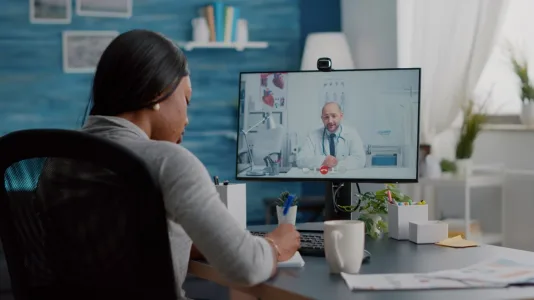

How Healthcare IT Solutions Improve Patient Care and Outcomes
- Real-time data access: Doctors can instantly view patient histories and lab results.
- Predictive analytics: AI models identify high-risk patients and prevent hospital readmissions.
- System integration: Seamless data flow between labs, pharmacies, and insurance systems enhances care coordination.
- Patient engagement: Portals and apps empower patients to track health, schedule visits, and communicate with providers.
By leveraging Healthcare IT solutions, hospitals can deliver more accurate diagnoses, personalized care plans, and timely interventions.
Future Trends in Healthcare IT Solutions
- AI-driven autonomous care platforms: Systems that proactively manage patient care without constant manual input.
- Expanded wearable and remote monitoring devices: Continuous health data collection and early warning systems.
- Interoperable cloud-based ecosystems: Smooth data exchange across providers and geographies.
- Population health analytics: Big data insights to manage disease outbreaks and chronic conditions at scale.
Conclusion
Healthcare IT solutions are no longer optional; they are essential for modern, efficient, and patient-centered care. From chronic disease management to complex oncology treatments, these solutions improve outcomes, streamline operations, and enhance patient engagement. Hospitals and clinics that invest in these technologies position themselves for better care delivery, operational efficiency, and long-term success.
Explore our Healthcare IT solutions today to transform patient care and achieve superior health outcomes.


